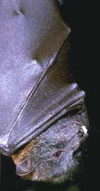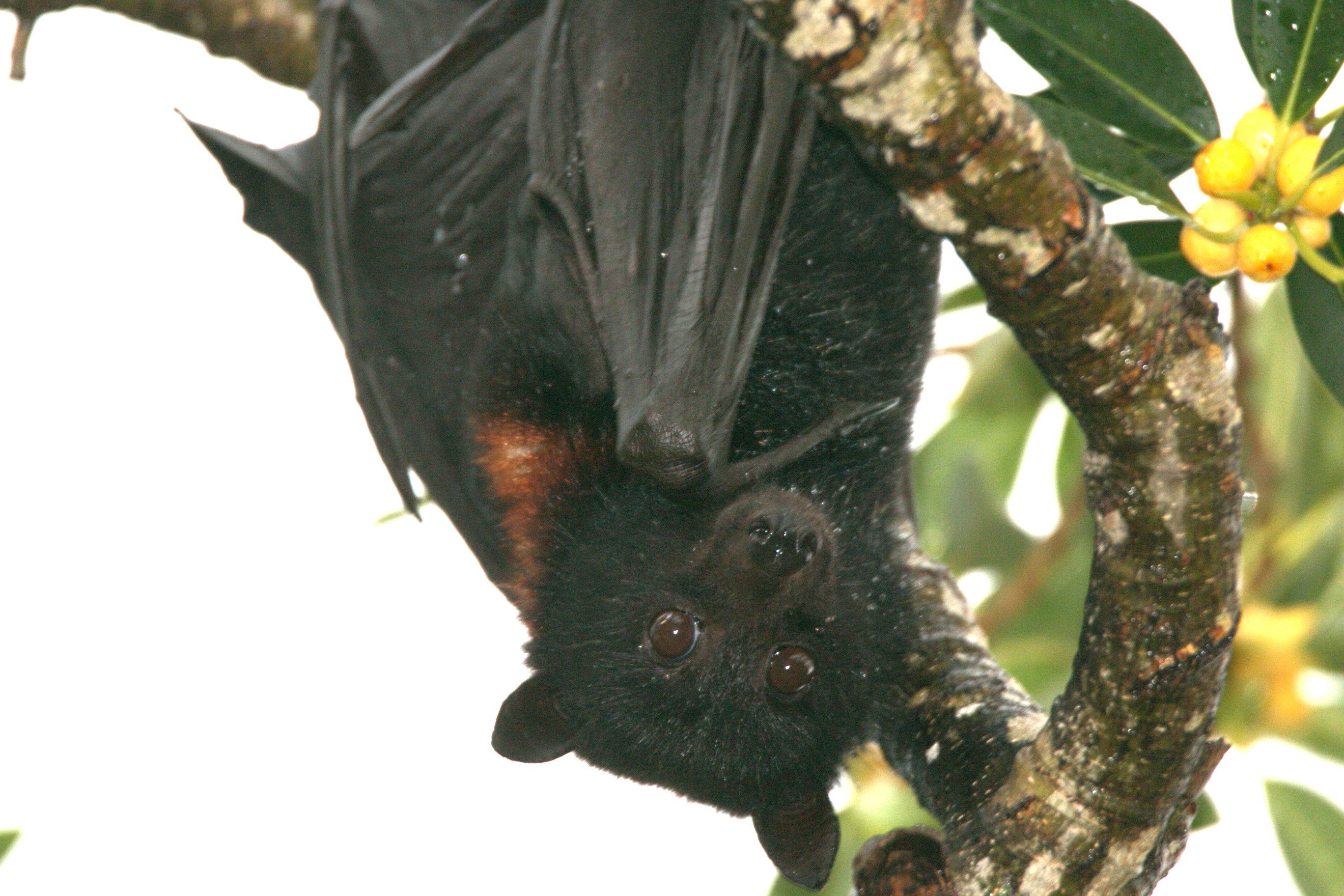Importance of flying-foxes

Flying-foxes play an important role in dispersing seeds and pollinating flowering plants and are crucial to keeping native forests healthy. Because flying-foxes are highly mobile, seeds can be moved locally and over great distances. When seeds are able to germinate away from their parent plant, they have a greater chance of surviving and growing into a mature plant. Seed dispersal also expands the gene pool within forests. Mature trees then share their genes with neighbouring trees of the same species and this transfer strengthens forests against environmental changes.
High mobility also makes flying-foxes very effective as forest pollinators. Pollen sticks to their furry bodies and as they crawl from flower to flower, and fly from tree to tree, they pollinate the flowers and aid in the production of honey. This reinforces the gene pool and health of native forests.
In turn, native forests provide valuable timber, act as carbon sinks, and stabilise river systems and water catchments, and provide recreational and tourism opportunities worth millions of dollars each year.
Understanding flying-foxes
Flying mammals


Bats are the only group of mammals capable of active flight. Fossils show that flying-foxes have been a part of the night sky for more than 35 million years. These bats may have been taking an opportunity to fill airspace left by the mainly day-flying birds.
There are two types of bats—the flying-foxes, which are all fruit and nectar feeders and their microbat relatives, the insectivorous bats. These two types of bats appear to have evolved separately, making them distinct groups of mammals. The ancestors of today's flying-foxes may have evolved from a primitive primate, meaning humans and flying-foxes may actually share a common ancestry.
Flying-foxes and their relatives range in size from the tiny blossom-bats that could fit in the palm of a human hand, through to the more familiar flying-foxes ‘fruit bats’, which can have a wingspan of more than a metre.
Night vision
Flying-foxes rely on well-developed vision to see at night, complemented by an excellent sense of smell to locate food. Their large, forward-facing eyes give them binocular vision, while mirror-like retinas reflect and capture the limited available light. Their sight allows them to use rivers, roads and other features as navigation aids. Their highly developed memories, allows flying-foxes to easily find previously-visited feeding sites and roosts and even roost branches.
Species living in Queensland
There are four species of flying-fox that you are likely to see in Queensland with another two species living in the Torres Strait Islands and a third, the bare-backed fruit-bat Dobsonia moluccensis, that only occurs in northern Cape York.
There is also a mystery species, the dusky flying-fox Pteropus brunneus that is only known from one specimen taken from Percy Island, off the central coast of Queensland, in the 1870s. It has never been seen again and is believed to be extinct.
The flying-fox family also includes four other closely-related species of bat. These are the blossom-bats (two species) and the tube-nosed bats (one species in Queensland and one from Moa Island in Torres Strait).
| Species | Habitat and distribution |
|---|---|
|
Bare-backed fruit-bat
Dobsonia moluccensis | Often roosts under piles of boulders and dense vegetation; found in northern Cape York. |
|
Black flying-fox
Pteropus alecto | Usually form camps in mangroves or paperbark swamps; found throughout eastern Queensland. |
|
Common blossom-bat
Syconycteris australis | Lives in rainforest in north Queensland and also heathland, paperbark swamp and coastal eucalypt forest in southern Queensland. |
|
Dusky flying-fox
Pteropus brunneus | Only one specimen known from Percy Island off the coast of central Queensland. |
|
Eastern tube-nosed bat
Nyctimene robinsoni | Usually found in rainforest throughout eastern Queensland. |
|
Grey-headed flying-fox
Pteropus poliocephalus | It can be found in open forest and rainforests along the east coast of mainland Australia south of Rockhampton. |
|
Little red flying-fox
Pteropus scapulatus | This species is nomadic forming temporary roosts in open forest, woodland, paperbark swamps and mangroves where trees are in flower or fruit. It occurs over much of Queensland. |
|
Northern blossom-bat
Macroglossus minimus | Found across a range of vegetation types from mangroves to rainforests in Cape York and north-east Queensland. |
|
Spectacled flying-fox
Pteropus conspicillatus | Found in or near rainforest in north-east Queensland. |
|
Torresian tube-nosed bat
Nyctimene vizcaccia | Occurs in rainforest on Moa Island in Torres Strait but also occurs in Papua New Guinea and the Solomon Islands. |
The social life of a flying-fox
Flying-foxes are social animals that live together in roosts—some roosts may be as small as a dozen animals but others can number in the tens or hundreds of thousands. A temporary roost of little red flying-foxes can include as many as one million individuals, with roost trees bending and breaking under their weight. Roosts are at their largest during the flying-fox breeding season. Roost management guidelines provide more information about breeding season timing for different species.
Roosts are often semi-permanent, sometimes dispersing seasonally or when food is no longer available nearby, or when an area is overtaken by the impacts of encroaching development.
Predators
By living in large numbers, flying-foxes are rarely affected by predators like pythons, crocodiles, goannas, owls and sea-eagles. These predators only take a few individuals, leaving the rest of the roost intact.
Breeding
For three species of flying-fox (black, grey-headed and spectacled), one young is born in spring or summer after a five to six-month gestation period. Young bats are carried by their mother for three or four weeks, fed on milk, and then crèched at the roost until they start to fly (at around two to three months old). Young are weaned when they are five to six months old, allowing the parents to gather in large roosts and mate again.
The little red flying-fox follows a similar pattern but is six months out of sequence with the other species, its young being born in late autumn or early winter. This species forms enormous breeding camps of up to a million individuals in late spring and early summer. The little red flying-fox is highly nomadic, moving camp every one to two months to feed on new patches of flowering trees.
Flying-fox language
When at a roost or feeding, flying-foxes ‘squabble’ loudly. This mixture of screeches and cackles is actually their way of communicating and allows them to establish their personal roost sites or feeding territories, ward off rivals, stay in touch with their offspring, and warn others of possible threats. The grey-headed flying-fox is known to have more than 30 specific calls. By listening and watching, it may be possible to link some of the flying-fox's behaviour to the calls it makes.
Diet and feeding
Flying-foxes eat flowers and fruit, and sometimes leaves, from over 100 species of native trees and vines. They supplement this diet by eating fruit from introduced plants found in gardens, orchards, parks and streetscaping.
Flying-foxes need access to sources of flowering and fruiting trees that can sustain their large roosts. They leave at dusk and use their well-developed sense of smell to find known feeding sites or search for new ones. They can fly up to 50 km in a night in their search for food. The spectacled flying-fox always camps near rainforest and is a specialist fruit-eater known to disperse the seeds of at least 26 species of rainforest canopy tree.
In their travels, flying-foxes disperse seeds in their droppings and carry a dusting of pollen from tree to tree, fertilising flowers as they feed. Eucalypts rely heavily on these pollinators, producing most of their nectar and pollen at night to coincide with when bats are active. Without flying-foxes, there is less cross-pollination between trees, particularly over larger distances, and less seed is set.
Watching flying-foxes
With forests continuing to give way to expanding settled areas it is important to watch out for the well-being of remaining flying-fox roosts to ensure the health of the habitats that rely on them. At times, bat counts will be carried out to check how these remaining roosts are coping with the pressures of shrinking habitat.
Watching flying-foxes and how they behave and interact with others can help you to understand how these fascinating creatures live: when they have young, what they eat, when they move to new feeding sites, and how changes to the weather and surrounding environment affect their behaviour and health—and warn us about emerging risks to their survival.
The government undertakes monitoring of flying-fox roosts in conjunction with the National Flying Fox Monitoring Program (NFFMP).
Future of flying-foxes
The long-term solution to living near flying-foxes is having a better understanding of their needs. This means identifying areas for protection and considering their desired habitat before undertaking development. Non-residential urban areas, such as parklands, golf courses and even cemeteries, can be planted with a range of native trees that provide both fruit (e.g. small-leaved figs) and nectar (e.g. eucalypts and melaleucas). This would help provide feeding sites for flying-foxes away from residential areas and provide corridors for them to travel between remnant forests.
Similarly, if natural food sources are available at the same time that commercial fruit trees are bearing fruit, flying-foxes are less likely to become a problem for the fruit industry.
Flying-foxes simply need somewhere to live. However, where huge congregations are conflicting with humans, it may be appropriate to attempt to disperse roosts to another location further away from residential areas.
Hall, L., and Richards, R. (2000). Flying foxes and fruit and blossom bats of Australia. Australian Natural History Series. UNSW Press.
Strahan, R. (ed.). (1995). Mammals of Australia, Reed.


